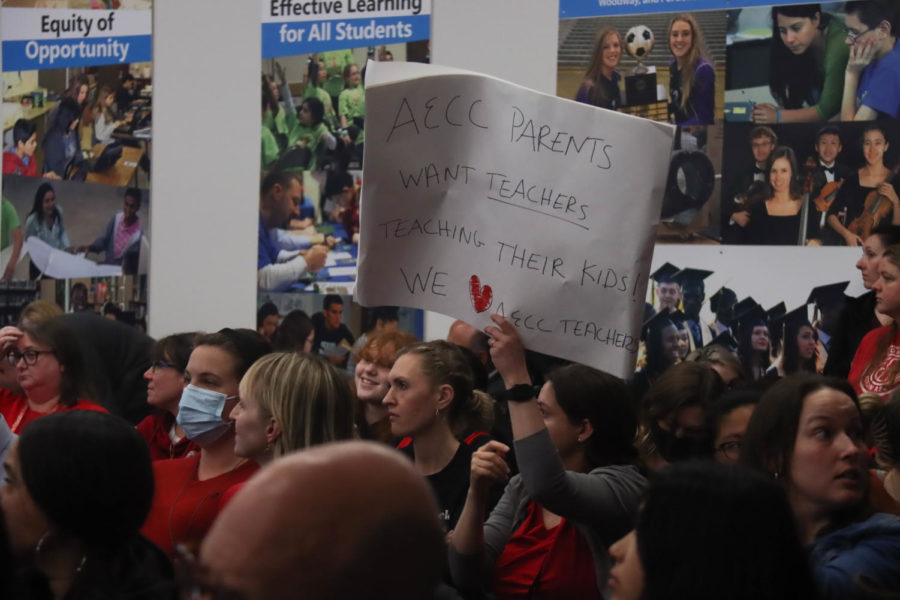Facing a $17.7 million budget deficit for the upcoming school year, the Edmonds School District Board of Directors voted 3-2 to approve a cost-cutting budget that led to an equivalent of 25.2 certificated teachers, an equivalent of 8.5 elementary assistant principals and two instructional technology coaches receiving layoff notices, as well as a reduction in classified staff including custodians, groundskeepers and paraeducators throughout the district.
The decision was made at a School Board meeting on May 14, which was necessary if layoff notices were to be delivered in time to meet the state-mandated deadline of May 15. Teachers, parents and other members of the ESD community filled every space available at the meeting to express their disapproval at the layoffs and spent hours delivering public comments on the issue, with the final decision ultimately being made shortly before midnight.
Among surrounding school districts, including the Everett, Lake Stevens and Marysville school districts, the ESD is the only district facing high layoff levels for the 2019-2020 school year. On the western side of the state, Tacoma Public Schools is facing similar issues as the ESD, laying off 31 staff members for the 2019-2020 school year due to a large budget gap.
Teacher layoffs are made based on seniority, with staff members having less than three years of employment within the district being the first to go. Under the approved plan, MTHS will lose one teacher.
All employee groups are being impacted by the approved budget cuts, with an 8.7 percent reduction in certificated administrative staff, a 4.2 percent reduction in classified staff and a 2.5 percent reduction in certificated instructional staff. The district has projected that kindergarten through third grade class sizes, which are protected and funded by the state, will not exceed 21 students. Fourth through sixth grade class sizes are projected to have an average of 27.6 students, while the district claims that the projected numbers for seventh through twelfth grade class sizes “appear typical.”
According to Andi Nofziger-Meadows, the president of the Edmonds Education Association, until the district adds more staffing to secondary schools, classes at the high school level could be between three and five students larger in the next school year. She also claims that 38 full- and part-time teachers will be affected by the cuts throughout the district, all except six of which work at middle or high schools. Most of the cuts affected teachers working in English and social studies departments.
In a 2012 McCleary decision, the Washington state Supreme Court ruled that the state was not providing enough money to school districts for basic education. In 2018, the state legislature and Governor Jay Inslee reached an agreement to give more money to fully fund what the Supreme Court deemed “basic education,” which involved an increase in statewide property taxes.
At the same time, however, lawmakers reduced how much money individual school districts could collect from voter approved local property tax levies, which many districts had relied on to fill in budget gaps.
As a result of these decisions, the ESD found itself losing nearly 20 million dollars spent on programs, staff and other expenses not classified as “basic education” by the state. Before the levy cap was imposed by the legislature, the ESD would receive $67.2 million a year from local levies. This year, with the levy cap in place, it will pull in approximately $48 million.
Along with the increased salaries for teachers negotiated last year, a new statewide health insurance program for educators will also add to ESD’s expenses in the 2019-2020 school year. Additionally, the state’s Salary Allocation Model no longer considers the educational experience level of staff and funding for staff salaries is now provided at a single average rate, and the ESD has a more experienced staff than the statewide average.
Although the state has increased revenue programs for special education, the district still has a higher special education budget than is provided by the state and federal governments. This gap in funding is projected to be $5 million in this school year.
The ESD anticipated some relief from the legislature through levy collections or equalization (dollars per student collected) last year, according to School Board member Gary Noble.
“At the end of last year, there was quite a bit of momentum that the legislature was going to give us some relief in either the levy collections or the equalization,” he said at the May 14 School Board meeting. “If they would have changed that one item, we would have had an extra $5 million.”
In addition, the legislature considered changing the maximum amount of dollars per student that the ESD and other districts could collect from locally-imposed property tax levies. While the state legislature has agreed to take action towards raising the levy lid, it will not be enough to close the ESD’s funding gap.
“We would have actually collected $10 million more in local levies, but that last night, the provision was changed to affect only districts with 40,000 students or more,” Noble said.
The ESD has 20,457 students throughout its elementary school, middle school and high school’s, according to the ESD May 2019 enrollment report.
While the district has acknowledged the severity of layoffs, officials claim that their options are limited by the fact that 87 percent of the ESD budget goes to employee salaries and benefits.
“We’ve been working hard at ‘How do we find 17.7 [million dollars]?’ with already a very lean budget,” ESD Superintendent Kris McDuffy said.
Prior to the School Board meeting held on May 14, the proposed budget was set to cause a reduction of up to 43 full-time ESD staff members and a decrease of 300 daily hours for paraeducators who assist students with disabilities in classrooms.
In general, around 145 ESD staff retire or resign each year, but these numbers were projected by the district to be lower going into the 2019-2020 school year. If this number increases by August, the district would consider recalling some of the terminated employees. However, currently the district’s identified retirement numbers are projected to be half of what they are in a typical year.
In addition to the layoffs, several vacant district positions will not be filled. These positions include groundskeepers, a special education data-processing specialist, a technology support specialist and three custodians. The district’s budget had also originally considered slashing $2.5 million to fund supplies and operations, but the vote on cuts to other areas in the budget was postponed.
For four hours, 59 concerned community members, students, parents and staff, many dressed in red to symbolize union support, voiced their concerns to the School Board before they made their final decision on the layoffs.
“I’d like my students to have the experience of more time and attention with their teachers on a daily basis, and with 169 students and going to two meetings a week for IEP’s and 504’s, it’s going to make it very difficult for me to do that,” MTHS history teacher Michole Mattix said.
Others voiced their concerns on larger class sizes creating school safety issues.
“Our science classes do not have the ability to seat more than 28 students safely because they have fixed lab tables that can not be moved. To go beyond 32 students per class is putting students and staff in an unsafe situation and endangering everyone in the classroom,” College Place Middle School science teacher Jenifer Higgens said.
Ciara James, a sophomore at Lynnwood High School, shared how dyslexia and ADHD made school difficult until her personal connections with teachers helped her to overcome the challenges that these conditions pose.
“All of last year, I was telling myself I wouldn’t be able to get grades above a C and I would always wake up and fight with my mom to stay home or called her at lunch to try to leave, but with the help of my teachers, this year, I don’t put up a fight to come to school and have all As and Bs.,” James said. “With bigger classes, it’s hard for those teachers to have those connections, and hard for the kid to do well in the class.”
Heather Damron, a mother to a fifth grader with autism, shared how her son thrived in his fourth grade class due to a small class size.
“We made big strides in his IEP goals, and he was starting to make friends,” she said. “I hoped for continued success, but this year has been a struggle, with a year full of regression, calls from the school and behavior I thought we had worked through.”
At the end of the meeting, though, board members voted to approve a budget that would issue layoff notices to 25 teachers. However, it was made clear that study sessions would take place as soon as possible to find alternate solutions and keep as many staff employed within the district as possible.
“We want staff, students and parents to know that Dr. McDuffy, our superintendent, and our school board will continue to work hard this spring and across the summer to address the budget issues we are currently facing,” Schwab said.
















